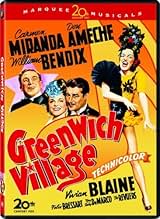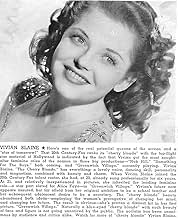AVALIAÇÃO DA IMDb
6,2/10
493
SUA AVALIAÇÃO
Adicionar um enredo no seu idiomaIn 1922, a would-be classical composer gets involved with people putting on a musical revue.In 1922, a would-be classical composer gets involved with people putting on a musical revue.In 1922, a would-be classical composer gets involved with people putting on a musical revue.
- Direção
- Roteiristas
- Artistas
Paul Hurst
- Milkman
- (cenas deletadas)
Bill Alcorn
- Costume Party Guest
- (não creditado)
Maceo Anderson
- One of the Four Step Brothers
- (não creditado)
Charles Arnt
- Author with Letter
- (não creditado)
Buddy Banks
- Clarinet Player
- (não creditado)
Oliver Blake
- Bigelow - Author
- (não creditado)
Herman Boden
- Chorus Boy
- (não creditado)
Avaliações em destaque
The film, not surprisingly, is set in Greenwich Village, New York (actually a sound stage at Twentieth Century-Fox) and begins with an eager young composer, Kenneth (Don Ameche), arriving in town--hoping to make it big. Soon, he meets up with Dan (William Bendix) and his friends at Danny's Den--the strangest speakeasy in Hollywood history. At this 'joint', Carmen Miranda and Vivian Blaine perform. After hearing some of Kenneth's music, Danny decides to put on a show to showcase his sweetie. The problem is that this sweetie (Blaine) might just be in love with Kenneth AND some sharpie (Felix Bressart) is interested in having the music performed instead by a big-name director instead of on some stage show in the Village. What's next? See the film....or not.
I am glad I watched this film when I did, as I had just finished watching a GREAT MGM musical, "Anchors Away". Although both films were in color, there weren't too many other similarities. "Anchors Away" had great music, singing, plot--everything. And, by comparison, "Greenwich Village" just looked tired and second-rate...which, is what it was. As for Carmen Miranda, she seemed unnecessary to the film and a bit lost. Additionally, fair tunes and the studio's lesser singers (Alice Faye was out on maternity leave), the film never really hit the mark and is a few steps below the average Fox musical of the period. And, when it was over, I couldn't remember much of anything about it. Adequate and no more.
By the way, I was VERY surprised to see Ernest 'Sunshine Sammy' Morrison in the film dancing and singing a musical number with a number of other black entertainers. While I was VERY familiar with him as a member of Our Gang (since its beginning) and the East Side Kids, I had no idea he was so talented in other ways.
I am glad I watched this film when I did, as I had just finished watching a GREAT MGM musical, "Anchors Away". Although both films were in color, there weren't too many other similarities. "Anchors Away" had great music, singing, plot--everything. And, by comparison, "Greenwich Village" just looked tired and second-rate...which, is what it was. As for Carmen Miranda, she seemed unnecessary to the film and a bit lost. Additionally, fair tunes and the studio's lesser singers (Alice Faye was out on maternity leave), the film never really hit the mark and is a few steps below the average Fox musical of the period. And, when it was over, I couldn't remember much of anything about it. Adequate and no more.
By the way, I was VERY surprised to see Ernest 'Sunshine Sammy' Morrison in the film dancing and singing a musical number with a number of other black entertainers. While I was VERY familiar with him as a member of Our Gang (since its beginning) and the East Side Kids, I had no idea he was so talented in other ways.
"Greenwich Village" is a musical from Twentieth Century Fox starring Don Ameche, Vivian Blaine, Carmen Miranda, and William Bendix.
The film seems a bit slapped together, especially in light of the fact that one of the numbers was actually footage from "Springtime in the Rockies" that was cut.
There's not much of a story - it concerns a young composer, Kenneth Harvey (Ameche) who meets Blaine and Bendix in a speakeasy. Bendix jazzes up Kenneth's concerto, intending to use it for a show, while Kenneth hopes to have it performed in a classical genre. Kenneth also falls in love with Blaine, whom Bendix considers his girl.
Miranda is a multipurpose performer at the Danny's Den, and has some cute numbers - "Give Me a Band and a Bandana," "I Like to be Loved By You," and "I'm Just Wild About Harry," all energetically performed in some wild costumes.
Vivian Blaine looks absolutely beautiful and sings well. Ameche gives a pleasant performance as someone experiencing New York and the Village for the first time.
A great deal is made here of Greenwich Village as a haven for artists, and the sets are very much like the neighborhood as it must have been in those days - crowded and brightly lit. The street that Danny's Den was on looks like West 8th Street, and it was fun to see.
"The Revuers" who included Judy Holliday, John Frank, Betty Comden and Adolph Green, alas, were cut from the film, and the best number was "It Goes to Your Toes" performed by "untitled black musicians" who were fantastic. They were possibly The Layson Brothers. The DeMarcos turned in some sprightly dancing.
This isn't one of Fox's blockbusters, but it has the tell-tale vibrant Fox colors, likable cast, and good musical numbers normally associated with musicals from that studio.
The film seems a bit slapped together, especially in light of the fact that one of the numbers was actually footage from "Springtime in the Rockies" that was cut.
There's not much of a story - it concerns a young composer, Kenneth Harvey (Ameche) who meets Blaine and Bendix in a speakeasy. Bendix jazzes up Kenneth's concerto, intending to use it for a show, while Kenneth hopes to have it performed in a classical genre. Kenneth also falls in love with Blaine, whom Bendix considers his girl.
Miranda is a multipurpose performer at the Danny's Den, and has some cute numbers - "Give Me a Band and a Bandana," "I Like to be Loved By You," and "I'm Just Wild About Harry," all energetically performed in some wild costumes.
Vivian Blaine looks absolutely beautiful and sings well. Ameche gives a pleasant performance as someone experiencing New York and the Village for the first time.
A great deal is made here of Greenwich Village as a haven for artists, and the sets are very much like the neighborhood as it must have been in those days - crowded and brightly lit. The street that Danny's Den was on looks like West 8th Street, and it was fun to see.
"The Revuers" who included Judy Holliday, John Frank, Betty Comden and Adolph Green, alas, were cut from the film, and the best number was "It Goes to Your Toes" performed by "untitled black musicians" who were fantastic. They were possibly The Layson Brothers. The DeMarcos turned in some sprightly dancing.
This isn't one of Fox's blockbusters, but it has the tell-tale vibrant Fox colors, likable cast, and good musical numbers normally associated with musicals from that studio.
It amazes me that other postings about films are so critical of movies intended to be entertaining fluff, for being fluff.
And trite? What movie today isn't a rehash of something already done over and over again?
Musicals of the time weren't intended to be "South Pacific" or "Oklahoma". The plots were devised to be excuses to have music or dance performances or comedy bits. You probably noticed that the plots are mostly "backstage" stories and the characters portrayed are singers or dancers.
Technicolor is always pleasing to the eye, and so are the performances of Vivian Blaine and Carmen Miranda in this film.
So just sit back and enjoy.
And trite? What movie today isn't a rehash of something already done over and over again?
Musicals of the time weren't intended to be "South Pacific" or "Oklahoma". The plots were devised to be excuses to have music or dance performances or comedy bits. You probably noticed that the plots are mostly "backstage" stories and the characters portrayed are singers or dancers.
Technicolor is always pleasing to the eye, and so are the performances of Vivian Blaine and Carmen Miranda in this film.
So just sit back and enjoy.
Here is a confection designed to be a showcase for the adorable Carmen Miranda. It is her first starring role and she is given a lavish showcase in which to weave her magic. Vivian Blane, a gorgeous redhead, is given ample opportunity to show off her singing talents. In all, this is a typical example of the Fox musical of the forties. As far as the color goes, no one did it better than Fox. The vivid Technicolor fairly jumps off the screen, and the print on my DVD is extremely well preserved. WW2 saw a whole series of vividly Technicolored Fox films which were designed to take one's mind off the troubles at hand. As escapism, they were light, fluffy confections with good cheer and lovely visuals taking the place of great dramatic weight. Fox Technicolor at this time could be called super-saturated. Very bright and with set and costume design done to take full advantage of the pallete. Most of these Fox musicals have been amazingly preserved, given their age, and all have a nostalgic entertainment value. They really don't make 'em like this anymore.
There are three excellent reasons to settle in with this Technicolor extravaganza: Carmen Miranda, Carmen Miranda, and Carmen Miranda! The "Brazilian Bombshell" is at the top of her dazzling talent and is featured in three production numbers, each with it's own nutty, colorful and surreal style--she never disappoints! The musical itself is a slight bauble about a classical pianist finding his heart in a speakeasy (Don Ameche has written a classical concerto with themes from the pop song "Whispering"!); Vivian Blaine, billed as the "Cherry Blonde," is so obviously an Alice Faye stand-in, doing her best to establish herself in the Fox Pantheon along with Faye and Grable; there is lots of dense color saturation in many scenes, making this a visual candy-colored treat, even if the material is lightweight wartime fluff. I never found it dull, and was always entertained; I gave it an "7" not because it's a deep or particularly thoughtful film, but because it accomplishes what it sets out to do perfectly. Entertain. Sometimes you just need a break
Você sabia?
- CuriosidadesThe Revuers (Betty Comden, Adolph Green, Judy Holliday and Alvin Hammer) received billing (as a group), but their one musical number, "The Baroness Bazooka," was cut from the release print. Their remaining roles are little better than extras.
- Erros de gravaçãoThe opening narration on the bus claims that George Gershwin was one of those legendary talents who got his start in Greenwich Village, but in 1922, when this film supposedly takes place, Gershwin was just starting out.
- Citações
Princess Querida O'Toole: Would you like to take advantage of me?
- ConexõesEdited into Carmen Miranda (1969)
- Trilhas sonorasI'm Just Wild About Harry
(uncredited)
Music by Eubie Blake
Lyrics by Noble Sissle
Performed by Carmen Miranda
Principais escolhas
Faça login para avaliar e ver a lista de recomendações personalizadas
Detalhes
- Data de lançamento
- País de origem
- Idioma
- Também conhecido como
- Greenwich Village
- Locações de filme
- Empresa de produção
- Consulte mais créditos da empresa na IMDbPro
- Tempo de duração1 hora 22 minutos
- Proporção
- 1.37 : 1
Contribua para esta página
Sugerir uma alteração ou adicionar conteúdo ausente

Principal brecha
By what name was Serenata Boêmia (1944) officially released in India in English?
Responda


















